Helichrysum citricephalum
Helichrysum citricephalum Hilliard & B.L.Burtt
Family: Asteraceae
Common names: Ixopo everlasting (Eng.)
Introduction
Helichrysum citricephalum has a unique combination of features and does not resemble any South African Helichrysum species, which makes it very easy to identify; it has a shrubby habit, fragrant, felted silver-grey leaves and bright lemon-yellow flower heads. This species is Critically Endangered, surviving on the very few remaining patches of natural vegetation among the forestry plantations and dairy pastures in its habitat.

Description
Description
Helichrysum citricephalum is a relatively large, densely leafy, robust shrub that grows up to 1 m tall. The main branches are bare, and rough with persistent leaf bases. The leaves are 30-50 x 7-18 mm, lance-shaped and are attached directly to the stem by the base without a stalk (sessile). Both leaf surfaces have a beautiful silver-grey colour and are densely covered with short hairs (felted). The peduncle is leafy and produces a set of up to 20 large, solitary, bell-shaped flower heads that are 15 mm long and 25 mm wide, and grow in a cluster at the same level at the tip of the peduncle. The floral bracts are glossy, pale lemon-yellow and surround the mass of darker yellow flowers in the centre. Helichrysum citricephalum flowers in late summer to early autumn (February to March).
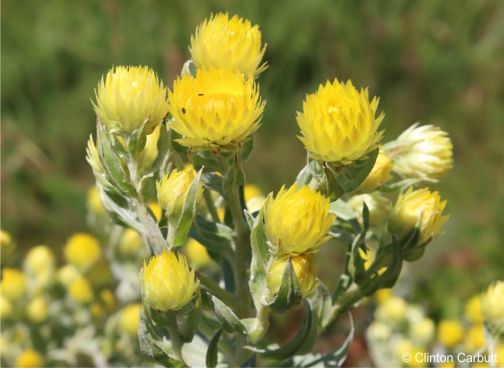
Although Helichrysum citricephalum does not closely resemble any Helichrysum species found in South Africa, it is allied to two East African Helichrysum species, namely H. kirkii var. petersii and H. buchananii .
Conservation Status
Status
Helichrysum citricephalum is assessed as Critically Endangered (CR) by the Red list of South African plants, meaning the species is facing a high risk of becoming extinct in the near future. It is a range-restricted species known from just one location and most of the population was destroyed when the road was widened some years ago. The remaining subpopulation of fewer than 200 plants is growing in the middle of a recently established illegal settlement, thus it is expected to decline further due to development and the degradation of the site. A second population recently found closer to Ixopo is estimated to contain up to 350 plants and is currently secure because the land use is secure and loosely managed in a way that happens to benefit the species.
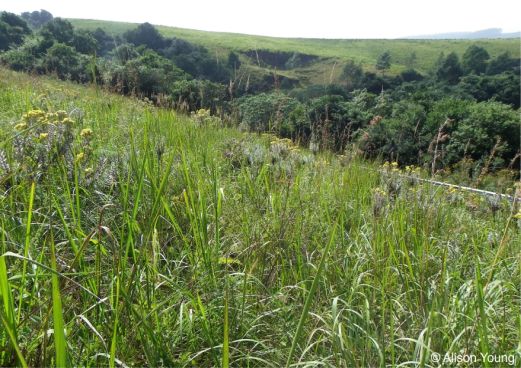
Distribution and habitat
Distribution description
Helichrysum citricephalum is endemic to KwaZulu-Natal, South Africa. The population is known to occur in one area between Ixopo and Umzimkhulu where it grows in Midlands Mistbelt Grassland, on steep shady banks in the transition zone between forest and grassland and on forest margins. The recently discovered population is growing above and along three short first-order drainage lines in a single small catchment area on cool, south-facing slopes. It favours dense, scrubby vegetation bordering drainage lines, forest margins and rocky areas that provide shelter from fires.
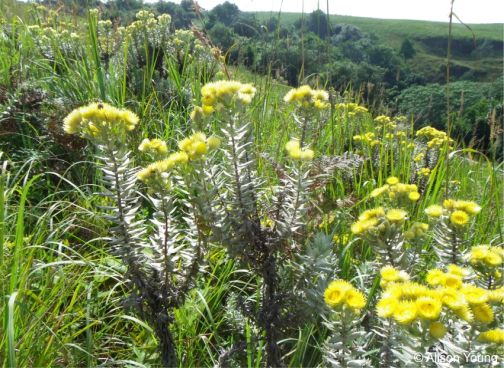
Derivation of name and historical aspects
History
The name Helichrysum is derived from the Greek helios, meaning ‘sun’ and chrysos meaning ‘gold’, which refers to the bright yellow flower heads of most of the flowers of the species in the genus. The species name is derived from citrinus meaning ‘lemony’ and cephalum meaning ‘head’, referring to the distinctive lemon-yellow coloured flower heads of this species.

Ecology
Ecology
The bright-yellow flowers of Helichrysum citricephalum attract beetles and butterflies, which pollinate them. The seeds are light in weight, with hairs that serve as a parachute, aiding dispersal by wind. The hairs on the leaves help prevent water loss.
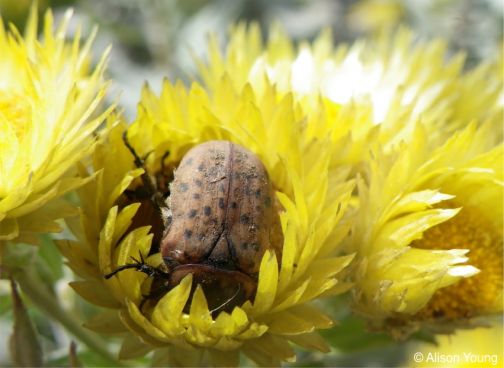
Uses
Use
Altough there are no records of any medicinal or cultural uses for Helichrysum citricephalum, in general, many species of Helichrysum are used medically to treat different illnesses. They are also known to have strong tissue regeneration qualities and are used to promote the growth of scar tissue in medicine, and have also been regarded in the past as potent aphrodisiacs for attracting a partner.
Growing Helichrysum citricephalum
Grow
Helichrysum citricephalum is not yet known in cultivation. However, it could make a great ornamental plant with its brilliant golden yellow flowerheads that can last for months.
This plant can be propagated by seeds and cuttings. Seeds propagated by the KZN National Botanical Garden were not a success, however seeds sown at the University of KwaZulu-Natal Botanical Gardens nursery were successfully germinated. The seeds were sown soon after collection in May. When sowing seeds, first clean off the parachutes to improve the seed’s ability to absorb moisture. Sow the seeds in a well-drained seedling mix at a depth equivalent to its diameter and lightly cover with a 1 mm thick layer of seedling mix. This helps to hold the seed in place in the tray or seedling bed. Seed trays are kept in a warm, well ventilated, and well-lit place. Seedlings can be pricked out at the two-leaf stage and transferred to seedling pots in soil with a ratio of 1:1 coarse river sand and potting soil.
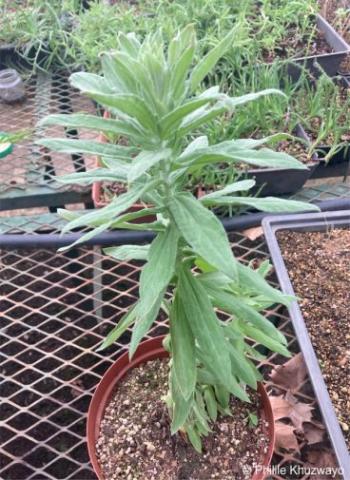
Semi-hardwood stem cuttings were also made soon after being collected in the wild in May. Fill a seedling tray with a mix of sieved coarse river sand and a potting medium. Water the pot well so there is moisture to the bottom of the pot. Create a cutting by cutting a 10 cm stem below the node. Remove the set of leaves and trim the foliage down by about a third, to reduce pressure on the cutting to support the transpiration of the leaves without a root system. Dip the node into a rooting hormone powder for semi-hardwood cuttings, increasing the chances or speed of the cutting forming a root system. Take the cutting, use a stick or a dibber to make a hole in the potted cutting mix and gently place the cutting in, nudging the mix around it, until your pot is full of cuttings. Do not water afterwards, as it will wash off the hormone. Use a spray bottle or mister to ‘water’ the foliage. Place in a warm location in a greenhouse. After 3 weeks, new shoots start emerging. In a few months the cuttings were fully established and potted into a 15 cm pot.
References
- Carbutt, C. 2021. A second population of the Ixopo Everlasting (Helichrysum citricephalum). Plantlife 51(4):1-15. https://plantlifesouthafrica.blogspot.com/2021/07/plantlife-volume-514-july-2021-second.html.
- Hassine, D.B., Khlifi, D., Ferhout, H., Raoelison, E.G. & Bouajila, J. 2016. Chapter 44 – Curry plant (Helichrysum sp.) oils. In Preedy, V.R. (ed.) Essential oils in food preservation, flavor and safety. Academic Press. pp.395-403.
- Koekemoer, M. & Steyn, H.M. 2010-02. Helichrysums of southern Africa. Helichrysum citricephalum Fact Sheet. https://keys.lucidcentral.org/keys/v3/helichrysum/key/Helichrysum/Media/Html/Helichrysum_citricephalum.htm.
- Scott-Shaw, C.R., Von Staden, L. & Victor, J.E. 2011. Helichrysum citricephalum Hilliard & B.L.Burtt. National Assessment: Red List of South African Plants version 2020.1. Accessed on 2024/01/12.
- Young, A. 2012-03. Observation of Helichrysum citricephalum, Ixopo, KwaZulu-Natal. iNaturalist. Online. https://inaturalist.org/observations/67567037.
Credits
Keitumetse Lenong and Philile Khuzwayo
KwaZulu-Natal National Botanical Garden
February 2024
Acknowledgements: the authors thank Alison Young, who runs the nursery in the UKZN Botanical Gardens and is part of BotSoc, for providing information and pictures, and Clinton Carbutt for making his images available.
Plant Attributes:
Plant Type: Shrub
SA Distribution: KwaZulu-Natal
Soil type: Loam
Flowering season: Late Summer, Autumn
PH: Acid, Neutral
Flower colour: Yellow
Aspect: Full Sun
Gardening skill: Average
Special Features:
Horticultural zones







Rate this article
Article well written and informative
Rate this plant
Is this an interesting plant?
Login to add your Comment
Back to topNot registered yet? Click here to register.